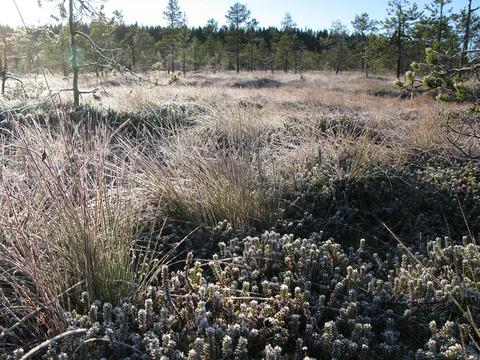当前位置:
X-MOL 学术
›
Funct. Ecol.
›
论文详情
Our official English website, www.x-mol.net, welcomes your
feedback! (Note: you will need to create a separate account there.)
Disentangling the effects of methanogen community and environment on peatland greenhouse gas production by a reciprocal transplant experiment
Functional Ecology ( IF 4.6 ) Pub Date : 2020-02-12 , DOI: 10.1111/1365-2435.13536 Heli Juottonen 1, 2, 3
中文翻译:

通过对等移植实验,了解产甲烷菌群落和环境对泥炭地温室气体产生的影响
更新日期:2020-02-12
Functional Ecology ( IF 4.6 ) Pub Date : 2020-02-12 , DOI: 10.1111/1365-2435.13536 Heli Juottonen 1, 2, 3
Affiliation

|
- Northern peatlands consist of a mosaic of peatland types that vary spatially and temporally and differ in their methane (CH4) production. Microbial community composition and environment both potentially control the processes that release carbon from anoxic peat either as CH4 or as carbon dioxide (CO2), a less potent greenhouse gas than CH4. However, the respective roles of these controls remain unclear, which prevents incorporating microbes in the predictions of peatland CH4 emissions.
- Here, a reciprocal transplant experiment was carried out to separate the influences of microbial community and environment in CH4 and anaerobic CO2 production. Peat from an acidic Sphagnum bog and a sedge fen with higher pH was enclosed in membrane bags with a pore size of 0.2 µm, preventing microbial colonization from the outside, and transplanted in the field for 2 months.
- Potential CH4 production was primarily controlled by the environment. The conditions in the bog suppressed the initially higher activity of fen methanogens and reduced CH4 production by 79%. Against expectations, the inhibition was not specific to acetate‐using Methanotrichaceae. Reciprocal transplantation favoured Methanosarcinaceae and potentially methylotrophic methanogenesis in general. Bog methanogens, mostly hydrogenotrophic Methanoregulaceae, retained their community structure and activity in the fen with a slight increase (+37%) in CH4 production.
- Anaerobic CO2 production was controlled by both the microbial community and the environment. Transplantation led to increased CO2 production in both bog (+50%) and fen peat (+57%) with distinct bacterial community, showing that the new environment directed more carbon to other anaerobic processes than methanogenesis.
- Taken together, these results relate differences in CH4 production of bogs and fens to ecophysiology of specific methanogen groups. The sensitiveness of fen methanogens to the acidic conditions in Sphagnum bogs can help explain the decrease in CH4 emission in the typical boreal peatland succession from young fens to older bogs. Increase in anaerobic CO2 versus CH4 production with transplantation shows that disturbances of boreal peatlands can activate poorly defined pathways of anaerobic decomposition.
中文翻译:

通过对等移植实验,了解产甲烷菌群落和环境对泥炭地温室气体产生的影响
- 北部的泥炭地包括一系列泥炭地类型,这些泥炭类型在空间和时间上都在变化,并且甲烷(CH 4)的产生量也不同。微生物群落的组成和环境都可能控制从缺氧泥炭中释放出碳的过程,要么是CH 4,要么是二氧化碳(CO 2),这种温室气体的排放力不如CH 4。但是,这些控制的各自作用仍不清楚,这阻止了将微生物纳入泥炭地CH 4排放的预测中。
- 在这里,进行了相互移植实验,以分离微生物群落和环境对CH 4和厌氧CO 2产生的影响。将来自酸性泥炭藓沼泽和pH较高的莎草粉的泥炭装入孔径为0.2 µm的膜袋中,以防止微生物从外部定居,并在田间移植2个月。
- 潜在的CH 4生产主要受环境控制。沼泽中的条件抑制了最初的产甲烷菌的较高活性,并使CH 4产生减少了79%。出乎意料的是,这种抑制作用并非专门针对使用乙酸甲烷菌科的乙酸盐。相互移植有利于甲烷菌科和潜在的甲基营养型甲烷生成。沼泽产甲烷菌,大部分为氢营养型甲烷菌,在芬芬保留了其群落结构和活性,CH 4产量略有增加(+ 37%)。
- 厌氧CO 2的产生受微生物群落和环境的控制。移植导致沼泽(+ 50%)和粉煤灰(+ 57%)中具有明显细菌群落的CO 2产量增加,这表明新环境将更多的碳引导至其他厌氧过程,而不是甲烷生成。
- 综上所述,这些结果将沼泽和的CH 4产生的差异与特定产甲烷菌群体的生态生理联系起来。苯甲烷产甲烷菌对泥炭藓沼泽地中酸性条件的敏感性有助于解释典型的北方泥炭地演替过程中从年轻的虫到年长的沼泽地CH 4排放的减少。移植产生的厌氧CO 2相对于CH 4的增加表明,对北方泥炭地的干扰可以激活定义不明确的厌氧分解途径。











































 京公网安备 11010802027423号
京公网安备 11010802027423号